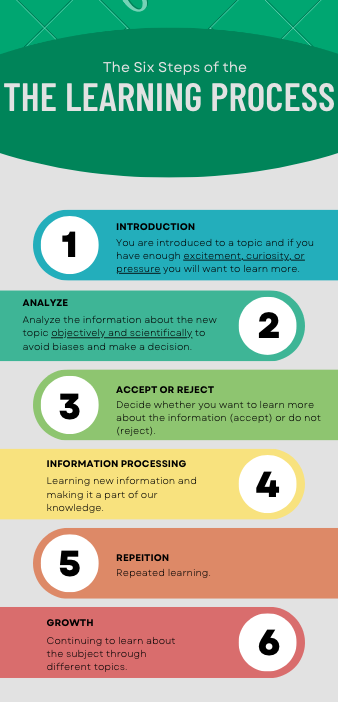What are the 6 steps of the Learning Process?


Have you ever wondered how we learn? Whether it is in school, at work, or on our own; whether it is learning a science, politics, human behavior, or how to play a sport – everybody goes through their own version of the same process in order to learn, understand and retain information. While you may not consciously realize the learning process you go through, there is a step-by-step process we all use when learning new information.
The six steps of the learning process are as follows:
Let’s dive into more detail about each of the steps, and the role they play from learning about a topic to becoming a subject matter expert in that field.
Step #1: Introduction
Every person who ever became an expert at anything started the same way as you and me; with a simple introduction to the topic at hand. Poker, basketball, poetry, snorkeling, parallel parking – that expert was once introduced to the topic.
How someone was introduced to the topic is not always important, but it does matter. If a person is introduced to a topic in an unfavorable way it will affect their willingness and interest to learn more. For example, if a child was forced to stay indoors and play piano while all their friends were outside having fun, they may resent the piano and not wish to continue learning.
Some ways people are introduced to a new topic include:
- Friends
- School
- Family (tradition)
- Online
- Fate
- Random chance
To move onto the second step and continue learning, however, an introduction is not enough.
The person usually has to be motivated by some internal or external factor to learn more about the subject.
The best motivators to keep learning are internal factors. An extreme curiosity about the subject at hand will motivate the individual to actively seek out more information about the subject. Curiosity and eagerness are two of the best traits to have when learning something new.
Even without a keen curiosity, external factors could still cause someone to learn more. This can be because of school requirements, work requirements, or to understand a family member/friend better. If there is still an eagerness to learn external factors can be motivating.
However, when you are excited, passionate, and curious about the subject you will seek out knowledge about it and indulge yourself in the topic more than an external factor forcing or nudging you in that direction.
Step #2: Analyze
This step is where the information is analyzed, and a decision is made on if it makes sense or not.
In much of our adolescent life, this step is sometimes skipped.
Most of us begin learning when we go off to school – after all, that is what school is for. The problem with most schooling, especially when we are young, is that we aren’t given the opportunity to analyze the information and decide whether it makes sense or not. We are just told the information and expected to process and retain it.
More curious individuals don’t just want to be told something, they want to understand it. “Why is x like this? What makes x like that and not like y? Doesn’t x contradict z?”
When we analyze information, we want to understand it. Just being told something is the way it is and being forced to memorize it will not be enjoyable and will not spark a person’s curiosity to learn more.
Especially in the digital age where misinformation is so easy to come across, this step is more important than ever when learning new information.
We need to thoroughly analyze and decide based on our past and current knowledge if the information makes sense. This can be based on other things we have learned in the past, our own life experiences, and common sense.
However, it is important to analyze the information objectively and scientifically to ensure that no biases come into play and that we are accurately dissecting whether the information in front of us makes sense or not.
Otherwise, we may need to unlearn and then relearn certain information in the future.
Truthfully, this step (and Step #3 which it goes hand-in-hand with) can sometimes come after Step #4 (Information Processing). However, it is typical to jump to quick conclusions, and often an introduction is more than enough to make our own analyses and minds up about a subject at hand, before diving deeper into learning. For that reason, this step can also come immediately after, nearly in conjunction with Step #1.
Step #3: Accept/Reject
Based on our analysis performed in Step #2, we either accept or reject the information we have.
If we reject the information – we typically stop learning about the subject. It becomes a waste of our time because we find it to be wrong, false, or even boring. The learning process ends here.
Rejecting the topic means we don’t necessarily think the information is wrong, but we are just not interested enough to keep on learning about it. This can be for a number of reasons. The external factors may no longer require us to learn, our curiosity has died down, or it was a topic we weren’t very interested in when introduced.
If our analysis of the current information leads us to accept the topic, we will go on to the next step.
Accepting means that we have processed and analyzed the current information we’ve learned (introductory information about the topic) and that we not only agree and have decided that it makes sense and aligns with our worldviews, but that we are still interested in the topic and want to continue learning more about it.
Step #4: Information Processing
This step includes:
- Processing
- Studying
- Retaining (sometimes)
- Learning
Our brains act like a database, taking in all the information that we have at our exposal. There are many methods to help us study and learn new information. We can:
- Make connections to things in life we already know
- Look for examples that we can relate to
- Research unknown words to try to remember key meanings, phrases, and slang within that category
The information process is the most recognized part of the learning process and is what most people will immediately think of when it comes to learning. This is where reading, studying and writing down information all come into play.
This is the part where you start to learn interesting facts about the subject at hand. If you ever find yourself sharing new information you recently learned with a friend, you are probably at this stage of the process.
Step #5: Repetition
Repetition involves the continuous studying of the topic until it becomes a part of our knowledge base and something we can easily refer back to.
Our brain goes through a series of hoops and obstacles in steps #1 – #4. Figuring out if the information is accurate, if it is something we even want to learn, and gathering initial information on the topic can all be exhausting to do. However, once we decide all these are true and worthwhile, we perform repetition.
This includes consistent studying, retaining, and learning of the information. It is essentially step #4 on a more dedicated scale. This is also where most, if not all, of information retainment occurs.
Step #6: Growth
Growth involves continuing to learn about the subject through different topics, expanding our knowledge.
For example, somebody fascinated with fitness might want to learn more about bodybuilding. Once they learn the general information about bodybuilding, they will dive deeper into the different subjects associated with bodybuilding. This can include the best exercises for building muscle, hypertrophy, how to cut weight, how to bulk, optimal rep ranges, and progressive overload.
I call this inner expertise – learning more details and getting more niche about a subject to become an expert in a specific field.
Somebody fascinated with fitness may also start with an overview of the fitness industry. They may learn about bodybuilding, then jump over to powerlifting, then CrossFit, then yoga.
I call this outer expertise – expertise on the subject overview but not specializing or dedicating all your time towards one specific topic.
There is no right or wrong way to do this (although I would argue internal expertise will open more job opportunities for you).
The beauty of learning is you can choose what you want to learn about and enjoy it.
–
When was the last time you learned something interesting? Which of the six steps was most challenging? Which was the most fun?
Let me know in the comments or directly at eric@ericgolban.com!
Best,
Eric


2 Comments